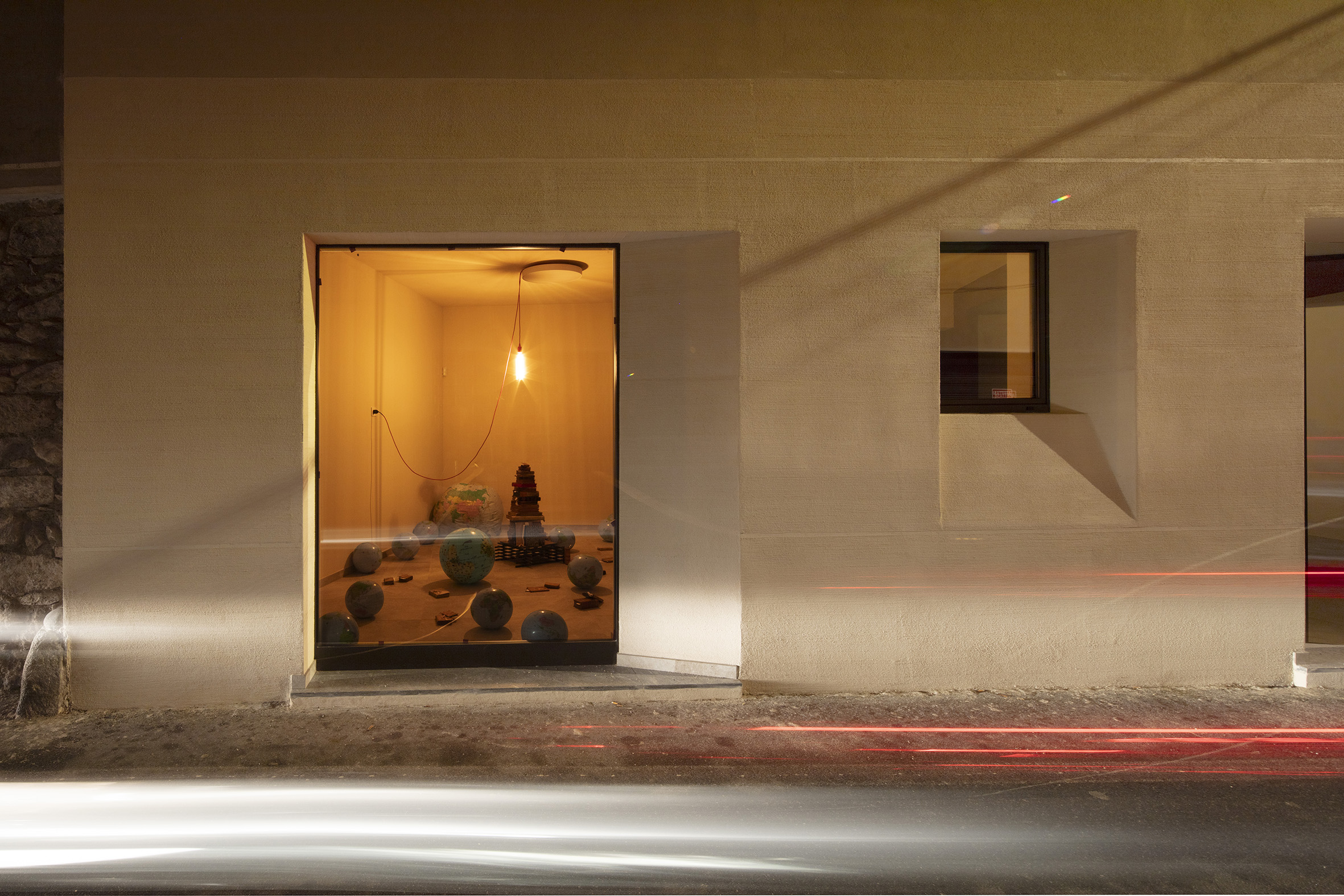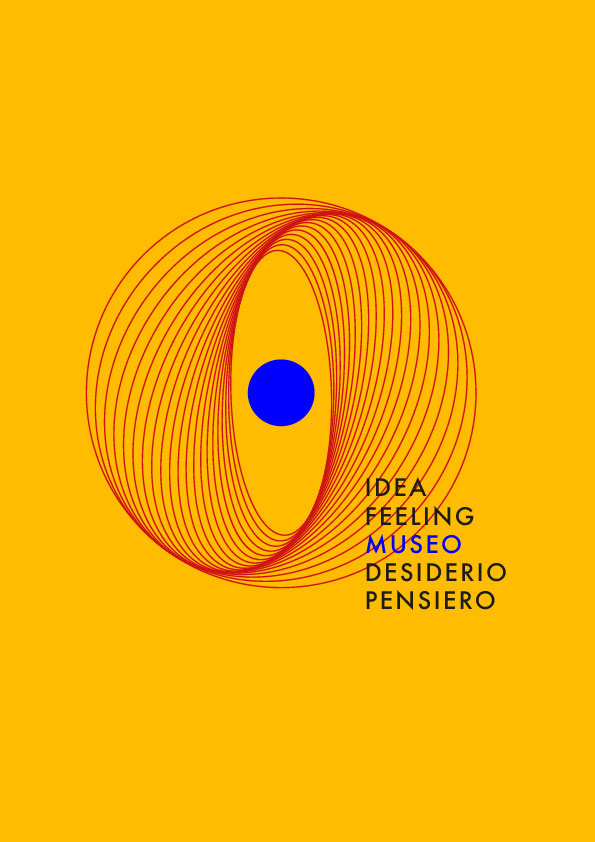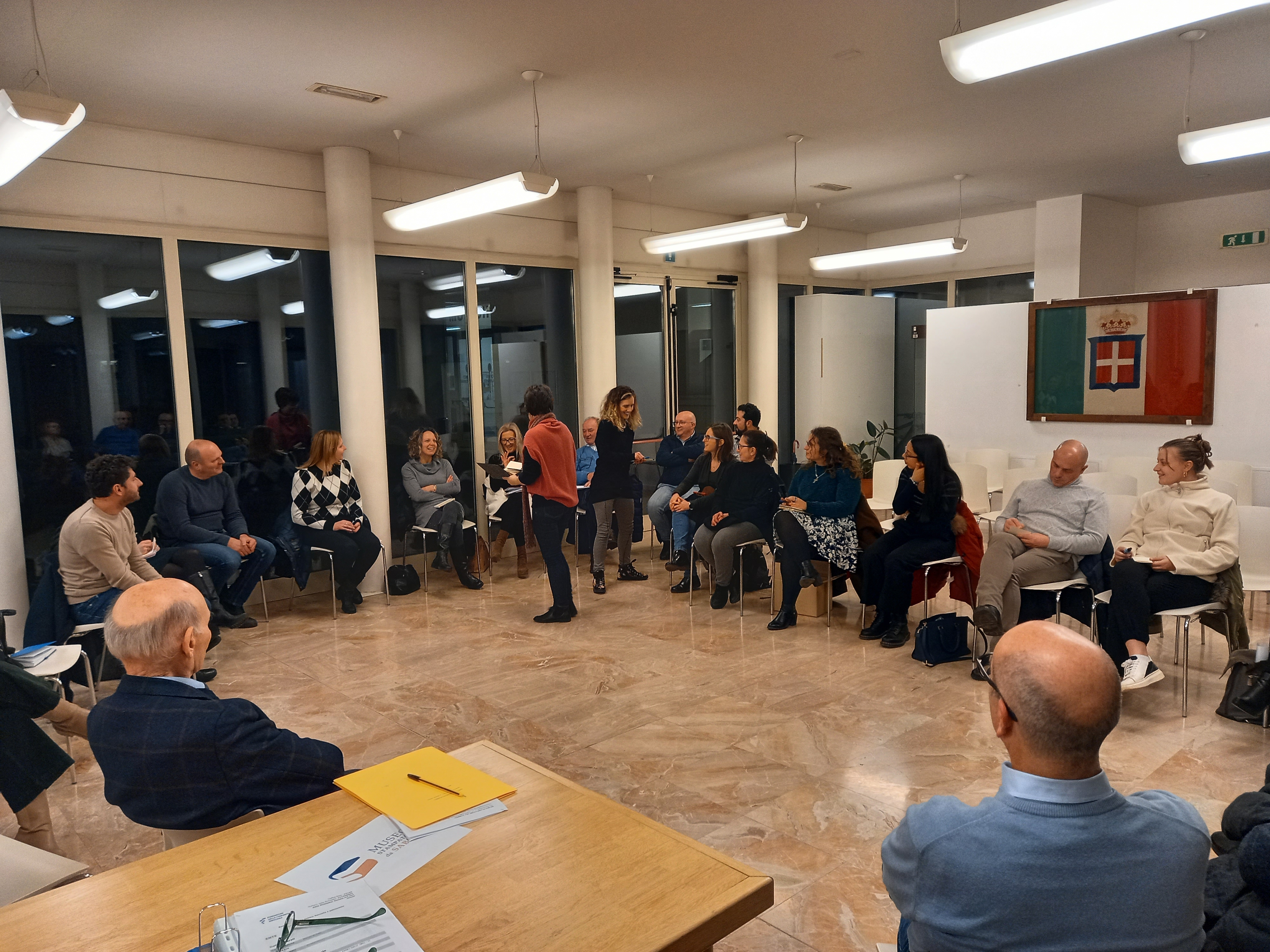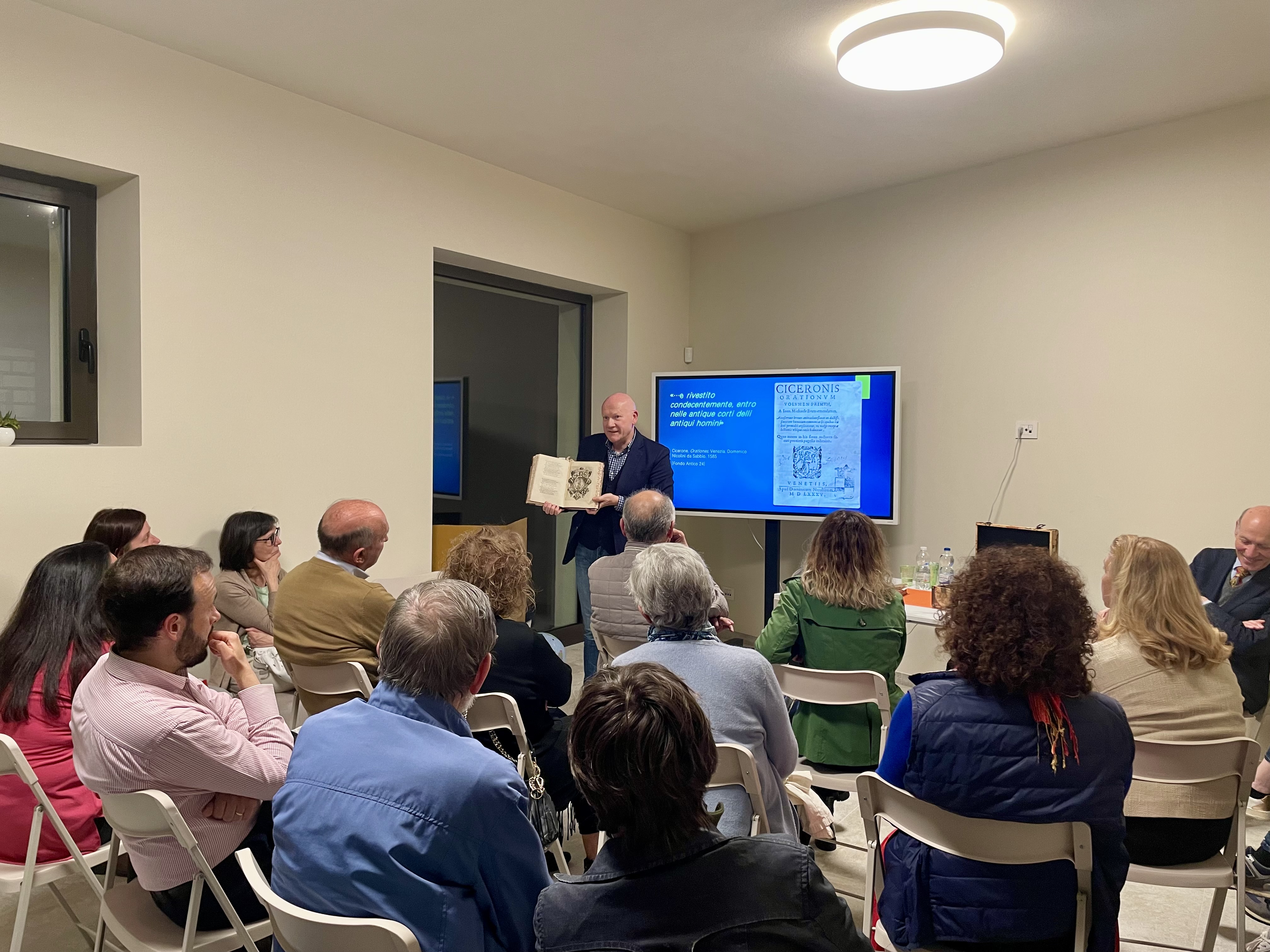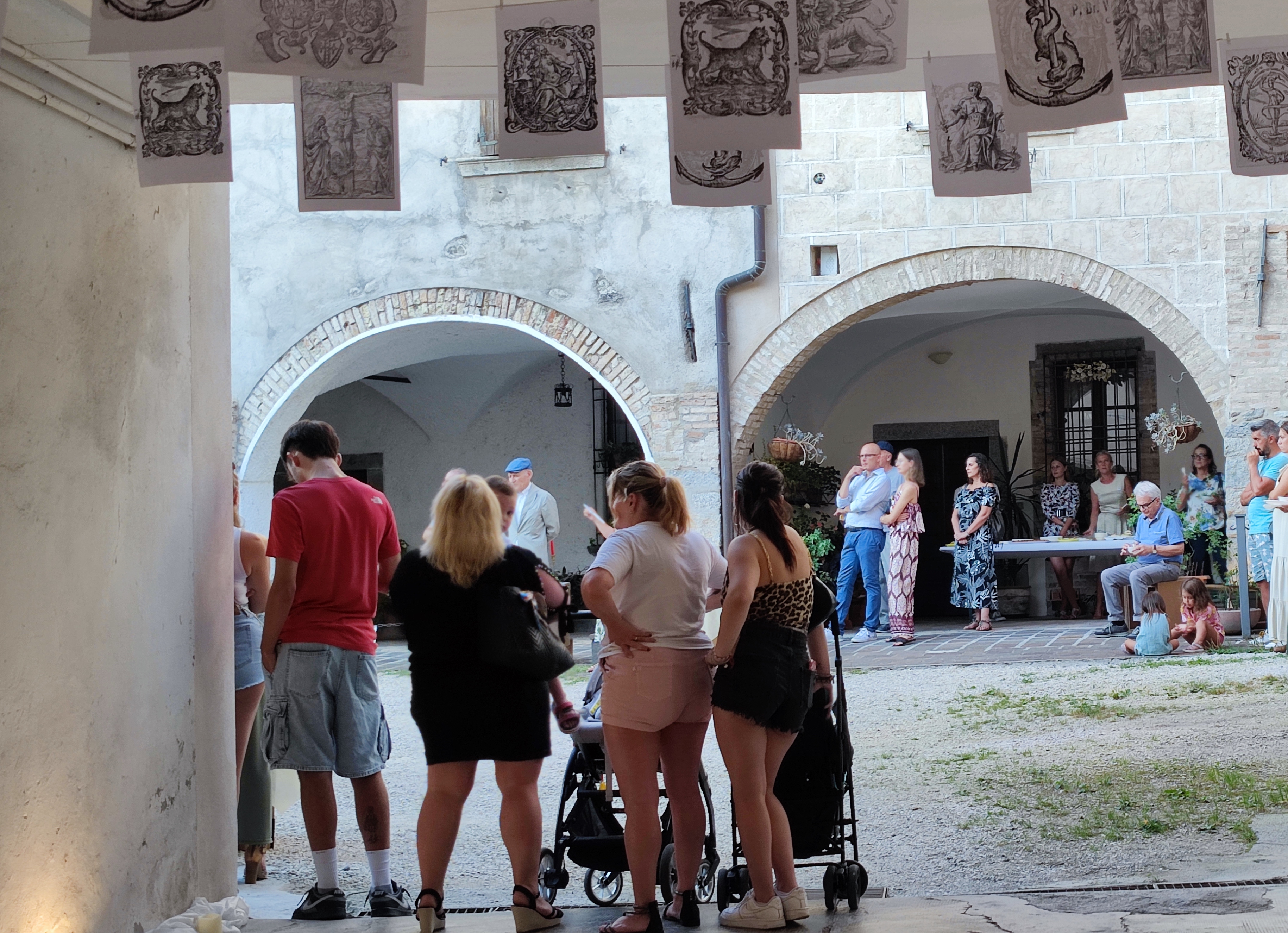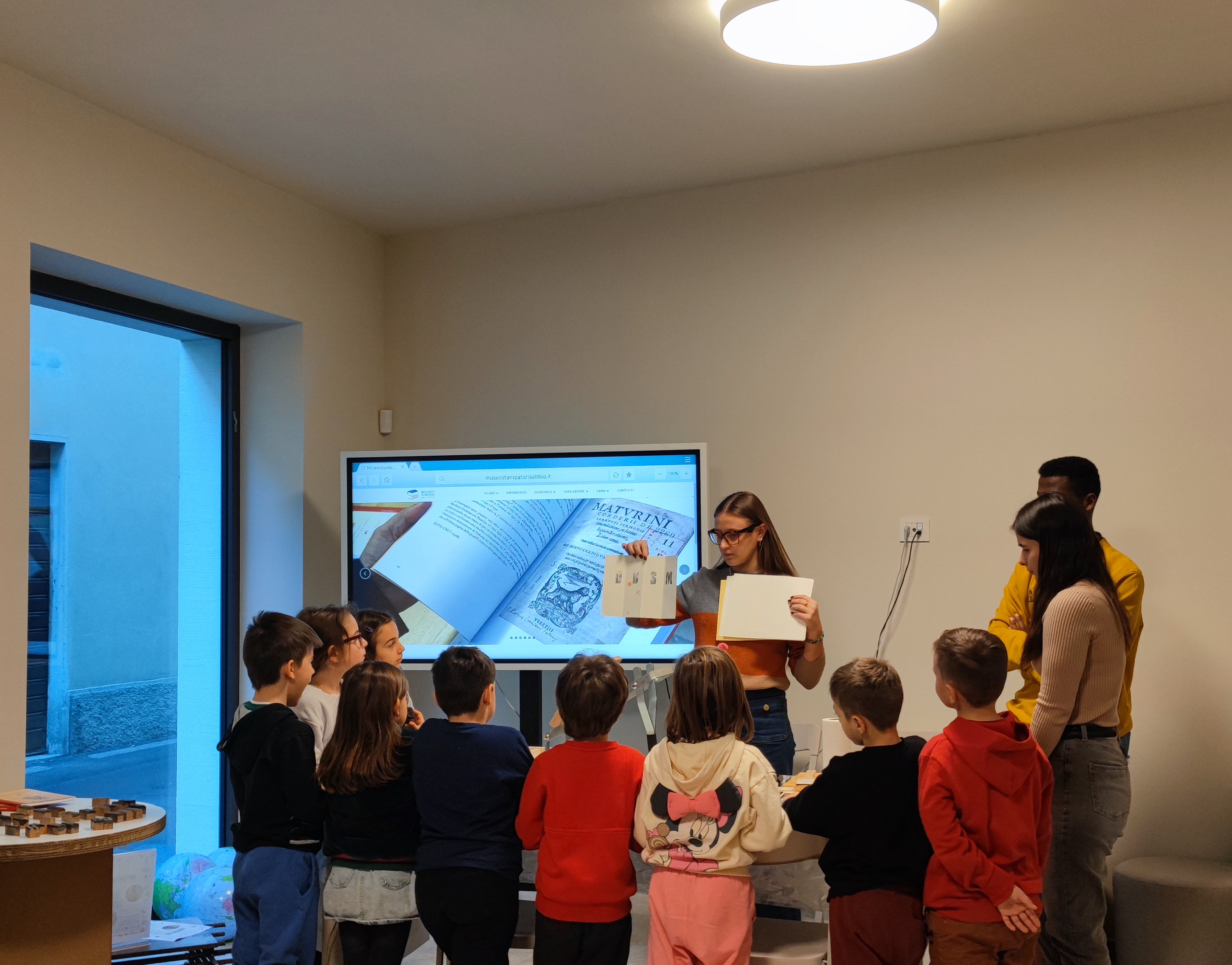Eredi_D’ONO_re
Eredi D’ONO re Participating cultural heritage: the Museo Stampatori ‘da Sabbio’
The museum was born from an ambitious idea: to recover and enhance the memory of enterprising typographers who, between the 16th and 17th centuries, travelled the paths of printing, frequenting the most important cultural centres in Italy and beyond. A spontaneous group of citizens has been taking care of it for a couple of years now, putting passion and competence into play, aware that the stories of the past are the living heritage of the community that reactivates them for future generations
Italy
Museo Stampatori da Sabbio
Via Parrocchiale 11/13
25070 Sabbio Chiese (BS) - Italy
Via Parrocchiale 11/13
25070 Sabbio Chiese (BS) - Italy
Prototype level
Yes
Yes
Yes
No
No
017168: Sabbio Chiese (IT)
The project, which has involved a group of citizens of Sabbio Chiese, a small municipality at the foot of the Alps in the province of Brescia, for some years now, has its roots in the intuition of Alfredo Bonomi, a ‘living heritage’ of the local community. It is to him that we owe the idea of bringing back and enhancing the memory, partially lost, of the ancient printers who, starting from Sabbio Chiese between the 16th and 17th centuries, became enterprising promoters of culture, moving among the most active centres of book production in Italy and Europe.
The Museum is dedicated not to printing in general, but to printers, to those ‘very fine men, who have for their own and innate profession the craft of book printing...’ (O. Rossi, Le memorie bresciane. Opera istorica et simbolica, Brescia, B. Fontana, 1616).
The donation of more than 40 antique volumes to the Municipality of Sabbio Chiese, by public institutions, ordinary citizens and local entrepreneurs made it possible, together with the donation of the building, to realise a dream, that of setting up a museum for the project. A couple of years ago, a spontaneous group of people, young and old, called together by the municipality, was born around the objective of setting up the museum, in the community-based dimension: a museum made by citizens for citizens, present and future, according to the indications of the Faro Convention. The primary recipients of the museum project are precisely the people who are conceiving it, sharing its premises and objectives, taking charge of the planning of the initiatives that animate it, aimed at the different audiences, up to the museographic set-up, whose participatory process has just been launched.
For an overview of the path taken by the Sabbio community so far, see https://museostampatorisabbio.it/.
The Museum is dedicated not to printing in general, but to printers, to those ‘very fine men, who have for their own and innate profession the craft of book printing...’ (O. Rossi, Le memorie bresciane. Opera istorica et simbolica, Brescia, B. Fontana, 1616).
The donation of more than 40 antique volumes to the Municipality of Sabbio Chiese, by public institutions, ordinary citizens and local entrepreneurs made it possible, together with the donation of the building, to realise a dream, that of setting up a museum for the project. A couple of years ago, a spontaneous group of people, young and old, called together by the municipality, was born around the objective of setting up the museum, in the community-based dimension: a museum made by citizens for citizens, present and future, according to the indications of the Faro Convention. The primary recipients of the museum project are precisely the people who are conceiving it, sharing its premises and objectives, taking charge of the planning of the initiatives that animate it, aimed at the different audiences, up to the museographic set-up, whose participatory process has just been launched.
For an overview of the path taken by the Sabbio community so far, see https://museostampatorisabbio.it/.
Comunità / Community
Benessere / Well-being
Cittadinanza / Citizenship
Patrimonio culturale / Cultural Heritage
Museo / Museum
The building that houses the museum dates back to the 1960s. It is located at the beginning of the town centre, on the street leading to the parish and the sanctuary. At the back, an ancient courtyard opens up, bordered by dwellings dating back to the 16th century. The original load-bearing structures have been retained and the interior has been redefined in terms of spaces and functions, to be refunctioned as a public place.
The renovation of the building, currently nearing completion, has already provided for the ‘bringing up to standard’ of the building, taking into account the most up-to-date systems of plant engineering (heating and lighting), as well as works aimed at anti-seismic adaptation and the removal of architectural barriers, to ensure the widest possible accessibility. Photovoltaic panels were installed to transform solar energy into electricity. The application of the cladding enables the containment and limitation of heat dispersion and the reduction of heating/cooling needs. The air/water heat pump reduces CO2 emissions by around 90% compared to a traditional heating system, and also avoids particulate emissions. For the building/installation finishes and the museum layout, a series of measures have been planned that are part of the integrated automation design, specifically through home automation interventions that have focused/will focus on lighting, in a self-regulating regime through special sensors, to turn on the lights most suitable for visitors' enjoyment of the ancient books. Further ‘intelligent’ systems will concern the stations inserted in the visitor route, useful to guarantee the most suitable conservation of the books on display and, at the same time, an accessible and effective use of the multimedia scenarios installed.
The renovation of the building, currently nearing completion, has already provided for the ‘bringing up to standard’ of the building, taking into account the most up-to-date systems of plant engineering (heating and lighting), as well as works aimed at anti-seismic adaptation and the removal of architectural barriers, to ensure the widest possible accessibility. Photovoltaic panels were installed to transform solar energy into electricity. The application of the cladding enables the containment and limitation of heat dispersion and the reduction of heating/cooling needs. The air/water heat pump reduces CO2 emissions by around 90% compared to a traditional heating system, and also avoids particulate emissions. For the building/installation finishes and the museum layout, a series of measures have been planned that are part of the integrated automation design, specifically through home automation interventions that have focused/will focus on lighting, in a self-regulating regime through special sensors, to turn on the lights most suitable for visitors' enjoyment of the ancient books. Further ‘intelligent’ systems will concern the stations inserted in the visitor route, useful to guarantee the most suitable conservation of the books on display and, at the same time, an accessible and effective use of the multimedia scenarios installed.
The project to musealise the tangible and intangible heritage of Sabbio Chiese has been proceeding for a couple of years on a parallel and complementary track: the realisation of the ‘building site of things’ and the ‘building site of ideas’.
The first involves the renovation of the building that houses the Museum, which is nearing completion, the acquisition of ancient books, through donations, and the supply of equipment that will be used to exhibit the books and set up the museum. The second involves the community of Sabbio Chiese in imagining the ‘type’ of Museum that they intend to create and make grow, through a participatory process that can count on the support of an internal consultancy service, offered by a special agreement with the university, for the engagement of citizens.
The first Notebook, published by the Museum in 2021, has a significant title: ‘For the Printers “from Sabbio”. Men and stories before the Museum' (https://www.museostampatorisabbio.it/assets/files/QuadernoStampatori_0_web.pdf). Local policy makers and citizens shared, from the outset, the importance of ‘designing’ the sense and purpose of the new cultural institution, dedicated to ancient printers, before its material realisation. The aim of the project, with respect to the people involved, is to recognise the cultural heritage received as a memorial and, at the same time, an educational resource for the citizens of the area, not only local. A small Working Group, in particular, has set up the Museum's Educational Services, which have already offered, on an experimental basis, a series of initiatives aimed at different audiences: lectures and conferences, routes and workshops for schools and families, showing ancient books, before their ‘musealisation’.
The first involves the renovation of the building that houses the Museum, which is nearing completion, the acquisition of ancient books, through donations, and the supply of equipment that will be used to exhibit the books and set up the museum. The second involves the community of Sabbio Chiese in imagining the ‘type’ of Museum that they intend to create and make grow, through a participatory process that can count on the support of an internal consultancy service, offered by a special agreement with the university, for the engagement of citizens.
The first Notebook, published by the Museum in 2021, has a significant title: ‘For the Printers “from Sabbio”. Men and stories before the Museum' (https://www.museostampatorisabbio.it/assets/files/QuadernoStampatori_0_web.pdf). Local policy makers and citizens shared, from the outset, the importance of ‘designing’ the sense and purpose of the new cultural institution, dedicated to ancient printers, before its material realisation. The aim of the project, with respect to the people involved, is to recognise the cultural heritage received as a memorial and, at the same time, an educational resource for the citizens of the area, not only local. A small Working Group, in particular, has set up the Museum's Educational Services, which have already offered, on an experimental basis, a series of initiatives aimed at different audiences: lectures and conferences, routes and workshops for schools and families, showing ancient books, before their ‘musealisation’.
The Working Group selected to set up the Museum's Educational Services is characterised by figures with different educational and professional backgrounds: it includes two secondary school teachers, a graduate in Oriental languages, an artist with a diploma from the Academy of Fine Arts and a teacher who has taught for many years at the primary school in Sabbio Chiese, as well as an educator who works with the elderly. A heterogeneous group that, appropriately guided and trained, has brought together skills and expertise to devise and conduct educational activities aimed at children and their families, as well as the school public, particularly primary and secondary schools. The Museum has already welcomed around 200 children, and has developed, at the same time, routes aimed at adults, in order to introduce them to ancient books, in a way that is accessible, both in terms of the subject matter and the language used. Currently, it is taking care of welcoming some students from the Istituto di Istruzione Superiore ‘G. Perlasca’ (Idro and Vobarno), both for PCTO routes (Percorsi per le Competenze trasversali e l'Orientamento), and for a collaboration with the editorial staff of the online school newspaper ‘L'Eco del Perlasca’. The new audiences that the Museum intends to involve are those of the local RSA-Residenza Sanitaria Assistenziale, which is a short walk from the Museum. Interaction with the guests of the RSA, in a condition of fragility, will soon make it possible to implement well being strategies, according to the most up-to-date theories of cultural welfare.
The wide audience of publics already investigated and to be intercepted, will guarantee the generativity of the learning process, built on the narration of the stories of our ancestors that represent the ‘hereditary characteristics’ of Sabbio Chiese, a small village, but open to the world. The objective is to ‘capacitate’ citizens to take care of and transmit the ‘hereditary characters’ they carry.
The wide audience of publics already investigated and to be intercepted, will guarantee the generativity of the learning process, built on the narration of the stories of our ancestors that represent the ‘hereditary characteristics’ of Sabbio Chiese, a small village, but open to the world. The objective is to ‘capacitate’ citizens to take care of and transmit the ‘hereditary characters’ they carry.
Following the donation of the building to be used as a museum in 2019, the municipality started the planning process for its renovation, taking into account that in 2008, a nucleus of antique editions had already been donated to the municipality, which was gradually enriched and is still being implemented. The concomitant challenge of involving citizens in the design of the museum, activated in 2022, was implemented through a number of public calls, in the form of an ‘invitation to citizens’. Specifically, on 14 November 2022 the initiative ‘A new neighbour, our museum’ was launched, which called citizens of all ages to gather around the project, whose visual identity had already been built through a collaboration with the students of the Accademia Santa Giulia in Brescia. On that occasion, the participatory process with the community was presented, which took concrete form, in a first phase, in three meetings held in the first half of 2023, returned to the citizenship in the second public meeting, entitled ‘Il Museo Stampatori da Sabbio ci mette la faccia.ta. The building site of things, the building site of ideas’, which was held on 2 December 2023. On this occasion, the ground floor of the Museum was ideally inaugurated with an installation of antique books, surrounded by a series of inflatable globes, to focus attention on the paths, the most varied, traced by our printers, with temerity and intelligence. The next event will be in the late spring of this year and will have as its theme ‘The Museum only grows if it is dreamed’, which picks up on a phrase by Danilo Dolci, poet and educator, to emphasise the importance of everyone's contribution to the design of the museographic itinerary, which will be inaugurated on the upper floor by 2026. The most significant and tangible impact will be the realisation and activation of the museum, in all its functions, shared by the community.
Numerous interlocutions have been activated, both at a local, provincial and regional level. First of all, for the renovation of the Museum, the Municipality had access to state and regional funds, also through participation in calls for tenders (e.g. GAL- Gruppo di Azione Locale Garda Valle Sabbia). The Museum, established by municipal resolution in January 2024, had already entered into an agreement with the University of Salò in 2020 to promote opportunities to study its bibliographic heritage. Moreover, in March 2024, the Museum was invited to join the Intermunicipal Pact for Reading 2023-2028 (https://opac.provincia.brescia.it/library/sistema-nord-est-bresciano/patto-per-la-lettura/). A specific agreement signed with the Università Cattolica del Sacro Cuore / CREA-Centro di ricerca per l'educazione attraverso l'arte e la mediazione del patrimonio culturale sul territorio e nei musei (https://centridiricerca.unicatt.it/crea_index.html), guaranteed scientific support within the participatory process. The Museum became part of the Sistema Museale della Valle Sabbia (https://sistemamuseale.cmvs.it/) in April 2024.
Several disciplinary areas are involved in this project. First of all, the disciplines related to the study of ancient books and publishing, paper and movable type. On the other hand, the participatory process involved both architecture and engineering for the realisation of the museum building and museography and museology for the layout on the upper floor. The technical competences were found within the village; the museographer who has recently started his collaboration for the setting up of the upper floor was instead identified, through a network of personal acquaintances, in an external consultant, already involved for another museum in the area. Communication is ensured through the support of the municipality, which has joined the Working Group dedicated to the creation of the website and the promotion of events. The Museum's institutional logo was conceived and realised by a group of students from the Graphics and Communication course at the Santa Giulia Academy in Brescia: the visual concept representing the Museum's poster, on the other hand, was interpreted by a local graphic designer. The support of an art historian and museologist from the academic world facilitated the initiation and conduct of the participatory process with citizens involving the field of educational sciences. Thus, multidisciplinarity has become interdisciplinary, as skills have intertwined/will intertwine to create a virtuous circuit.
The undoubtedly most innovative element consists in the experimentation of the participatory process not within a consolidated structure in terms of architecture, contents and roles, where recognised professionals come into play for/with the community, on the occasion of more or less sporadic initiatives and events. The originality of this project lies precisely in the fact that the museum has been made and will be completed with the contribution of the citizens, who are called upon, in a pact that to date has been informal with the Municipality of Sabbio Chiese, to take care of the local heritage. This is undoubtedly a challenge, which will have to take into account, in the future, when the Museum will operate effectively, the skills acquired by the most active members of the various Working Groups. Some of the volunteers, in fact, discovered aptitudes and interests they did not think they possessed. The learnings, once consolidated, can be put back into play for the Museum. In fact, the participatory process does not end with the opening of the Museum, but will have to continue in the running of the Museum, so that it is always alive and can generate new learning.
The citizens of Sabbio Chiese have long been urged to enhance their heritage. In addition to the Stamp Museum project, the town offers other important cultural resources, such as the Sanctuary of the Madonna della Rocca and the ‘E. Morelli’ Museum of Rural Civilisation. Having said this, however, it should be pointed out that, despite their traditional entrepreneurial and supportive character, local citizens had never been involved in processes of a participatory nature until the museum project presented here. The mediator, community-engager, had actually experienced this within the Sistema Museale della Valle Sabbia, in the form of the ‘community map’. The skills acquired at that time thus made it possible to experiment the participatory approach for the Sabbio Chiese Museum, which is inspired, without technicalities, by the Participatory Action Research model (Cf. P. Orefice, La Ricerca Azione Partecipativa. Theory and Practice, Volume I, 2006). Meetings with citizens took the form of focus groups, debates, and situational tasks. The informal learnings activated were thus multiple and applied, little by little, to the different mediation contexts in which the project has developed, and will develop.
The museum project fielded in Sabbio Chiese is undoubtedly transferable to other contexts, both in terms of content and the participatory methodology adopted.
As Tomaso Montanari writes (cf. Italian Constitution: Article 9, 2018, p. 88), Italy is made up of many ‘relative masterpieces’ and every borgo, every contrada has its specificities. The greatest challenge is undoubtedly to bring them to the surface, to enable citizens to recognise the cultural heritage they have inherited, to maintain it over time. And, above all, to do it together.
Participatory processes, by all actors, internal and external, take a long time to conceive and plan. Objectives, even if clear and shared, from the outset, need negotiation and continuous adaptation to contingencies. Working with people is, however, a highly satisfying operation from the human point of view, even if the outcome cannot be foreseen from the outset. One must always bear in mind that the process is more important than the product, and tenacity is rewarded by enthusiasm and the beneficial contagion between people of different ages who cooperate with each other.
As Tomaso Montanari writes (cf. Italian Constitution: Article 9, 2018, p. 88), Italy is made up of many ‘relative masterpieces’ and every borgo, every contrada has its specificities. The greatest challenge is undoubtedly to bring them to the surface, to enable citizens to recognise the cultural heritage they have inherited, to maintain it over time. And, above all, to do it together.
Participatory processes, by all actors, internal and external, take a long time to conceive and plan. Objectives, even if clear and shared, from the outset, need negotiation and continuous adaptation to contingencies. Working with people is, however, a highly satisfying operation from the human point of view, even if the outcome cannot be foreseen from the outset. One must always bear in mind that the process is more important than the product, and tenacity is rewarded by enthusiasm and the beneficial contagion between people of different ages who cooperate with each other.
In an ambitious and visionary approach, the highest aim of an operation such as the one experimented in Sabbio Chiese is to develop democratic competences, for the construction of cultural citizenships. It has been written that that of the museum is a ‘soft power’, but it can certainly contribute to guiding the direction of policy makers with respect to the management of the territory and its resources. The participatory process is a space of freedom, free from constraints. All the members of the various working groups work for free, because they are convinced that ‘heritage’ means ‘wealth’, not in the economic sense of the term, but as a sedimentation of values in/on the community. Finally, as also emerged in the first focus groups of 2023, ‘citizenship’ for the citizens of Sabbio means ‘belonging’, with a privileged look at places. This is an important reflection, bearing in mind the risk of depopulation that small villages are suffering year after year, especially in peripheral areas. The project presented here is ‘museum specific’, because it holds together the idea of a museum with the deep-rooted heritage it takes on. And if the roots are firmly established, the branches can ‘go far’, as did the printers who ‘from Sabbio’ centuries ago, travelling to distant lands, encountering different languages and cultures. The ‘movable typefaces’ identify not only Gutenberg's invention that made it possible to start modern printing, but also recall the dynamism of intelligences that has no boundaries, neither spatial nor physical.
In the near future, the working group involved in the participatory design of the upper floor of the museum will provide its contribution, according to the specific creativity of each, in order to share a layout corresponding to the shared input, with the support of an expert museographer.
A second step will be characterised by the formalisation of the working group, which may find a suitable configuration, e.g. in a cultural association. It is precisely to the cultural association, through the stipulation of a cooperation agreement, that the municipality will be able to formally entrust the management of the museum, the ownership of which remains with the municipality. Finally, we imagine that it is the association itself that will take charge of the museum activities, especially with respect to the operation of the Educational Services, which represent an essential hub for the contemporary, accessible and relational museum.
With respect to NEB's working principles, the project incorporated the participatory process, in the dimension of co-development with citizens, for the co-construction of the Museum. With respect to Multi-level engagement, to date, the involvement of citizens/stakeholders has settled on a dimension of dialogue with public and private institutions at provincial and regional level. Multi-level engagement was ensured at the local and supra-local level, through membership of the Sistema Museale della Valle Sabbia and collaboration with a university research centre. The museum project intends to expand the network of connections, in a global operational dimension.
The Transdisciplinary approach has seen different competences collaborating together, in a dimension of working alongside groups formed by citizens. When the association is set up and the cooperation pact with the municipality is signed, the citizens will acquire a more pronounced representativeness, capable of autonomous dialogue with the public body.
A second step will be characterised by the formalisation of the working group, which may find a suitable configuration, e.g. in a cultural association. It is precisely to the cultural association, through the stipulation of a cooperation agreement, that the municipality will be able to formally entrust the management of the museum, the ownership of which remains with the municipality. Finally, we imagine that it is the association itself that will take charge of the museum activities, especially with respect to the operation of the Educational Services, which represent an essential hub for the contemporary, accessible and relational museum.
With respect to NEB's working principles, the project incorporated the participatory process, in the dimension of co-development with citizens, for the co-construction of the Museum. With respect to Multi-level engagement, to date, the involvement of citizens/stakeholders has settled on a dimension of dialogue with public and private institutions at provincial and regional level. Multi-level engagement was ensured at the local and supra-local level, through membership of the Sistema Museale della Valle Sabbia and collaboration with a university research centre. The museum project intends to expand the network of connections, in a global operational dimension.
The Transdisciplinary approach has seen different competences collaborating together, in a dimension of working alongside groups formed by citizens. When the association is set up and the cooperation pact with the municipality is signed, the citizens will acquire a more pronounced representativeness, capable of autonomous dialogue with the public body.

